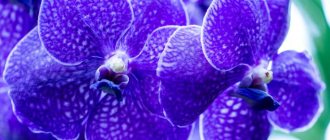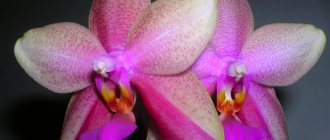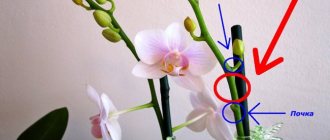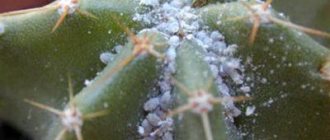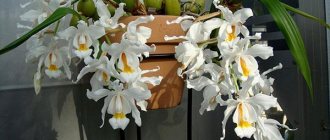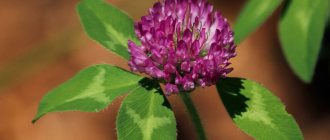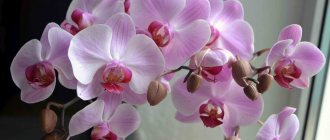Orchids are perhaps the most attractive plants in the world and are popular among flower lovers in every country. There is nothing surprising about this - the petals are of unusual shape, size and the fact that they grow quite quickly - help them stand out from many other indoor flowers. However, the most original orchid is, of course, the blue phalaenopsis.
Description and characteristics of blue phalaenopsis
Phalaenopsis orchid is a plant that grows on tree branches and feeds by means of aerial roots. The leaves have a pronounced green color, have an elongated shape and a shiny surface, and are arranged in the same way as in many other types of orchids - in two rows. The stems of the plants are short, and the peduncle is long, sometimes reaching 1-1.5 meters.
There is no specific schedule according to which phalaenopsis blooms, since it grows in tropical forests. In most cases, flowering occurs in late spring because there is more natural light at this time.
Phalaenopsis propagation occurs by vegetative method. To do this, cut off the side shoots extending from the peduncle or rosette of leaves. After the first roots form on the shoot, you can plant it in your own pot.
Pests and diseases
- Spider mites are the most common “pest” for burgundy orchids; they multiply very quickly and practically eat the plant. For any ticks and other pests, flower growers recommend immediately spraying the orchids with a special solution or soaking the roots in an insecticide for 15 minutes and quarantining them (at least for a month).
- Various rots, especially in summer, affect the roots and leaves of a weakened orchid; the flower can rot and die. If you see rotting of the root, you immediately need to save the flower: replant it, carefully cut out all the rotten roots with a knife. “Wounds” should be disinfected, sprinkled with cinnamon and lubricated with oil.
- Fungus in the bark, on the leaves.
An urgent transplant is needed here. The contaminated substrate must be changed. The pot must be disinfected, as well as the windowsill or place where the pots are placed. Use spraying with a solution of phytosporin or any other antifungal drug. Dosage preparations should be very modest, since the medicine, if it is erroneous, negatively affects the root system as a whole. To disinfect the roots, they can be treated with 3% hydrogen peroxide. - Yellowing of leaves - the orchid has “overheated” in the sun. Move it to darker places. Falling buds and leaves - not enough light. If it is autumn or winter, use additional lamps and increase daylight hours.
Attention! Beware of drafts. Do not place pots over heating radiators.
Is phalaenopsis blue?
The answer to such a question will most likely disappoint lovers of exotic plants, since in nature there are no such shades of buds of this variety of flowers. This is due to the fact that phalaenopsis lacks the gene responsible for the blue color of the petals. If you see such a plant with blue flowers on the counter of a flower shop, you should know that they are colored.
An orchid with large white flowers and a yellow edging is used as the base. In most cases, in order to color it, injections are made with a dye directly into the peduncle or its base. Sometimes they begin to dye phalaenopsis by pouring tinted water over it, then not only the flowers, but also the leaves and the root system turn blue.
See what types of orchids there are.
Coloring at home
You can make your phalaenopsis blue yourself, and you will save a decent amount of money and choose exactly the shade of blue that you like. This procedure is simple , even a beginner can carry it out without any problems. The main thing is to adhere to this scheme:
- First we choose a plant. It is best to take a phalaenopsis with white flowers, healthy, without diseases and pests;
- The next step is to select a coloring element. It is better to give preference to special means for coloring flowers or, at worst, food coloring. The final result depends on what blue orchids are painted with;
- The process ends with the choice of a staining method and its immediate implementation.
After all this, the trunk will need to be given a little more attention , since any dye will negatively affect the condition of the plant.
Phalaenopsis in the process of staining.
paint when the peduncle has fully grown and the flowers on it gradually begin to bloom. This period will be the most favorable; the coloring pigment will quickly get into the flowers and minimally damage the trunk.
Advice! Do not carry out the dyeing procedure at every flowering, this may take the last of the plant’s strength and it will die.
Methods
There are two ways to change the color of phalaenopsis:
- The easiest way is to regularly water the trunk with colored liquid. You will notice changes in color quite soon, but the dye will also quickly leave the stem. Loss of color will begin immediately after watering is stopped;
- The second method is less humane: in order to get phalaenopsis with blue flowers, you need to give it “injections” of color. Typically, such injections are carried out into the roots, stem or peduncle of the trunk. After this, marks usually remain on the plant that will be noticeable for a long time.
Advice! If you decide to use the second coloring method, give “injections” into the peduncle. This way you will do the least harm to the orchid.
Is there a blue phalaenopsis?
For many years, breeders conducted numerous experiments trying to develop orchids of unusual colors. Scientists from Japan managed to achieve blue color. They presented a phalaenopsis, which they named “Royal Blue”. The plant actually had a bright blue hue. To obtain this color, breeders introduced the gene of an orchid from Asia, Commelina, into the white flower of the Aphrodite species. The introduced gene was responsible for the blue color of the petals. Thus, the resulting hybrid began to bloom with buds of the required color.
This variety of orchids blooms profusely with small flowers, the size of which does not exceed 5 cm. Up to 30 buds can form on one stem.
This orchid is an exclusive flower; it is currently impossible to find it in stores.
Do such plants exist in nature?
There are no phalaenopsis with blue flowers in nature . Such plants cannot be found among hybrids either. Why do stores sell such exotic flowers?
You buy an orchid that pleases with blue flowers throughout its flowering period, then it begins a dormant period. With the necessary care, after some time the phalaenopsis again expels the peduncle. And here, instead of blue ones, gray-blue flowers appear, and sometimes white ones. Beginner flower growers look for mistakes during care, but this should not be done, since it is not their fault.
Blue flowers are obtained through conventional dyeing, which is carried out using a special technology. Over time, the paint washes out and the plant takes on naturally colored flowers.
In large flower shops, information about colored plants is placed near the flower shelves. Some unscrupulous sellers actively sell painted standard , inflating the cost. And the quality of coloring can be very low. Or they are completely silent about it.
How did the blue phalaenopsis orchid appear?
The world's first blue orchid was exhibited at an international exhibition in America. The flower aroused great interest among people, and just a few months after the event, Phalaenopsis blue (Royal) was presented at the Dutch flower competition.
It should be said that the manufacturers openly say that this shade is the result of coloring using a secret technology that has received a patent. Accordingly, in the future the orchid will bloom with white flowers.
History of appearance. What is Phalaenopsis Royal Blue
The very first phalaenopsis of an unusual color was presented not so long ago, in 2011 in Florida, USA. There is an annual exhibition of tropical plants, and the local was the first to think of coloring the flower. The Dutch became followers almost immediately: just a few months later, at an exhibition in the Netherlands, the nursery “Geest Orchideeën” presented the Royal Blue Phalaenopsis (Phalaenopsis Royal Blue). The variety won the award in the “Sales Concept” category.
The creators do not keep silent that this range is just the result of coloring, and the next flowering will already have white buds. However, they refuse to disclose the technology. All that is known about this from the manufacturer’s words: the flower is kept for some time in a special environment with elements of natural origin. This allows you to avoid causing harm to the plant.
Be careful: unscrupulous companies often pass off orchids dyed using barbaric methods as Royal Blue, which allows them to inflate the price. It is recommended to purchase the desired variety only from reliable suppliers.
Rules for caring for blue phalaenopsis
Home care for blue orchids does not differ significantly from care for other types of this flower. The main condition for the successful growth of blue phalaenopsis is ensuring optimal humidity, heat and light.
The required level of humidity can be achieved by regularly spraying the flower with a spray bottle. It is necessary that the water is not too cold, the optimal temperature is 18-20°C.
In order for the phalaenopsis to have enough light, it should be placed on a window located in the south, southwest, southeast.
On sunny summer days, you need to provide the plant with shade, otherwise it may get burned. The temperature during the day should not exceed 20°C. At temperatures below 15°C and above 25°C, the orchid may become sick, growth will be slower, and other problems associated with flowering may arise.
From personal experience
My first acquaintance with orchids began with the blue phalaenopsis. In December 2011, I saw a blue phalaenopsis in a store and couldn’t resist buying it. Only at home, when I began to look carefully, suspicion arose that the flowers were not evenly colored, the leaves were not green, but with a blue tint.
First home flowering
Care after purchase
When a flower is brought to a new place, its buds may begin to fall off. In such a situation, it is necessary to assess the condition of the root system. If the paint was injected into the roots, then it will no longer be possible to help such a plant. In the case where the pigment is injected into the peduncle itself, the chances that the orchid will emerge will be higher.
Find out why orchid leaves crack in half.
To resuscitate a painted phalaenopsis, you need to cut off the stem filled with a dye. Then carry out the following manipulations:
- Remove the plant from the pot. This must be done carefully so as not to injure the roots.
- Rinse the root system thoroughly using warm water. In this case, all roots should be checked for the presence of injection marks. If the paint was introduced through the roots, then rotting will be observed in the area where it was injected.
- All affected areas must be cut off.
- Then the cut areas need to be treated with ash. They need to dry well.
Next, the flower can be planted in a pot, into which fresh substrate should be poured.
The substrate in which the plant was previously must be thrown away. It cannot be used again, since it contains many chemicals and other harmful substances that were used to paint the phalaenopsis.
The Mystery of the Blue Flower
About 4 thousand different species of orchids grow in nature. They can be found on all continents except the northern parts of our planet. There are 65 types of Phalaenopsis. They are full of bright shades: white, purple, yellow, lilac, green, burgundy, lilac. The number of colors dazzles the eyes, but there is only one tone missing – blue.
The only secret of the blue phalaenopsis is that it is white, with an injection of blue paint. Rich, heavenly shades of inflorescences do not please for a long time with lush clusters of flowers. Within a month the buds will begin to fall off. Most often, for long flowering and bright color, a chemical solution is injected into the trunk, roots or arrow.
Many stores do not try to hide this information from customers; they place marks on flowerpots. Many gardeners simply do not notice the warning and purchase them, later becoming disappointed in the flower.
If the sprout survives, the rebloom will produce a white flower stalk. In this type, manufacturers achieve uniform coloring. In those places from which orchid specimens are transported, flowers are considered as disposable decorations for a holiday. After the arrow dies, the bush is disposed of.
Russia is distinguished by purposeful people who want to get out of a dying plant. Such procedures are a hobby for many gardeners who are inspired by the process of resuscitating a withering sprout.
So not everything on the counter is blue. Before purchasing, it is recommended to carefully examine the bush for punctures and diseased roots. It is best to choose real shades to avoid disappointment and losing a lot of money.
Reproduction
If you want to start growing orchids at home, then below are 3 methods to do this.
Children
You can remove scales from a dormant bud using a sharp blade and then apply cytokinin ointment. Make sure that the kidney itself is not injured .
Or put wet sphagnum moss on the bud and then cover it with polyethylene. Soon the desired children and the first roots appear.
Cuttings
The peduncle is cut off at the base and divided into parts 3-4 centimeters long . There should be a dormant bud in the middle of each cutting. The sections are sprinkled with charcoal powder and then placed in a warm, damp place. The same sphagnum moss is an excellent source of maintaining moisture.
Advice : You can do it easier. When the peduncle has stopped blooming, it is cut off and placed in a solution with fertilizer. It is necessary to provide the cutting with enough sunlight, then after 1-2 months shoots will appear on it.
We recommend watching a video about orchid propagation by cuttings:
Dividing the socket
If the plant is large and healthy, then it usually has an additional rosette with its own roots. In this case, the young rosette is separated with a sterile knife or pruning shears, treated with ash or charcoal, dried, and then planted in a new pot. Watering is carried out on the third day after transplantation .
We recommend watching a video about orchid propagation using the rosette division method:
External characteristics
The height of an adult specimen is a distinctive characteristic of the Midi type. These plants do not grow higher than 50 cm - this indicator takes into account the size of the peduncle during the period of active flowering.
Since Midi orchids are monopodial flowers, all the leaves are collected in a basal rosette and the adult plant numbers 4-6 pieces. Over the course of a year, Midi produces an increase of 1-2 leaves from the upper growth point, and the lower leaves gradually die off.
With the beginning of the flowering period, erect peduncles are formed from the leaf axils - depending on the variety, their number varies from 1 to 5 pieces. The maximum height of Midi peduncles is 30 cm and is a characteristic of the type.
The flower shape, like that of all phalaenopsis, resembles a moth or butterfly. Two large side petals - petalia, one modified lower one - lip (labellum), and three identical sepals - sepals in various variations give rise to magnificent flowers. The maximum diameter reaches 6 cm.
History of artificially bred species
The first artificial interspecific orchid was created back in 1856 by John Dominy, and 7 years later, he grew a hybrid of two different plant genera. The next step in selection was the method of growing this flower on special sterile media, which was developed by the American scientist Knudson in the 20s of the last century.
Thanks to her, it became possible to highlight the most remarkable properties of seedlings and develop them. Today, the number of artificially bred orchid species has already exceeded hundreds of thousands.
Of the huge number of phalaenopsis varieties, flower growers increasingly prefer the fragrant Wild Cat flower, the charming Multiflora, the delicate Liodoro, the elegant beauty Big Lip and the popular Mix subvarieties. The species diversity of pink, yellow and white phalaenopsis also attracts attention.
Sky-colored varieties
When talking about blue orchids, the first thing that comes to mind is vanda . The natural habitat of this beautiful flower is southern China, Thailand, northern and eastern India. The plant is distinguished by powerful roots that go to a depth of three meters. But its most important feature is the variety of colors: yellow, red, white, even speckled and striped. Unfortunately, caring for this variety requires a lot of effort and experience, so you are more likely to find a hybrid in stores than a real vanda.- Ascocendas are the most common artificially bred specimen among orchid connoisseurs. It was formed by crossing the aforementioned vanda and ascocentrum and also has a magical blue color. The flower is not very whimsical and grows at home without much difficulty.
- However, most often found on our shelves is blue phalaenopsis . The name of the flower comes from the Greek phalania - “night butterfly” and opsis - “resemblance”, since its discoverer initially mistook these orchids for fluttering insects. The plant is easy and pleasant to care for even for a novice gardener, and you can admire the flowering of the variety almost all year round. There are also shades for every taste: from soft white to rich purple. But here lies the catch: phalaenopsis does not have a natural blue pigment! Then what are they selling us so actively in stores?
Landing rules
Priming
In nature, the flower grows on trees, attached to the bark. The substrate for a home beauty should be similar to natural conditions.
The mixture includes: pieces of bark, coarse sand, humus, lowland peat, perlite, charcoal, drainage made of expanded clay or pebbles at the bottom (up to a third of the height of the container).
Sphagnum moss is laid on the surface.
Optimal capacity
Clay pots work well for the development of red orchids. Transparent containers allow you to better control the condition of the plant.
Deadlines
The need to move a flower to new soil occurs no more than once every two years. The roots sticking out of the pot signal that it has become cramped. The correct time for this procedure is after flowering has ended.
Orchids are replanted every two years.
Diseases, pests and their treatment
When keeping and breeding orchids, one should not forget about pests and plant diseases. Such as:
- rot (black, brown, gray, fusarium);
- defeat by powdery mildew;
- anthricosis;
- spider mite;
- scale insects, thrips.
The plant is affected by fungi, bacteria, and parasites. If a plant has a viral infection, it should be eliminated, since it is not possible to cure it.
Scale insects, aphids, mites and other parasites require careful treatment of the plant with preparations - phytoverm, and replacement of the substrate.
To destroy the scale insects, water procedures are carried out on the plant, the parasite is removed from all parts of the orchid, and treated with Aktelik and Fitoverm. Treatment is carried out once a week.
If root rot is detected, the substrate should be replaced immediately. The container should be washed and dried, the root system should be cleared of rotten fragments, and rinsed with a solution of foundationazole or topsin 0.2 percent. After 10 days, repeat the treatment. It is necessary to plant in a clean, disinfected substrate. For prevention, it is necessary to ensure good air supply to the roots and maintain optimal substrate humidity.
When affected by furasiose rot, use foundationazole. Treat 2-3 times a day for two weeks with a 0.2 percent solution.
Fungal diseases (anthracnose, powdery mildew, etc.) pose a danger to orchids. Fungicidal substances are used against the development of fungi. Fundazol, Topsin-M, Skor suppress fungal diseases of plants.
Myths about black varieties of orchids
The most common myth about the appearance of the black orchid is associated with the name of a botanist who is believed to have stolen this flower from a South American aboriginal tribe, where it was considered a totem plant.
For this act, the scientist was subjected to severe torture, however, thanks to his suffering, the world became aware of the existence of this wonderful flower.
A more romantic story of the appearance of the black orchid is associated with the story of unhappy love. However, skeptics have a different opinion: they confidently claim that the black orchid was bred artificially by Californian scientists.
